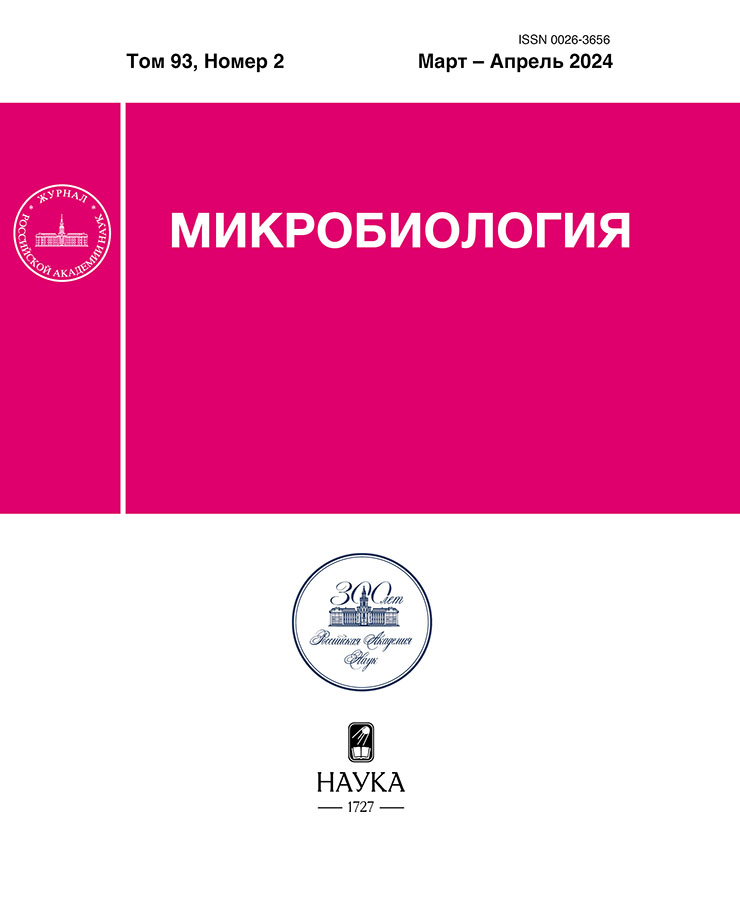Identification of Electron Transfer in the System of Ferredoxins and Ferredoxin Reductases from Mycolicibacterium smegmatis
- Authors: Epiktetov D.O.1, Karpov M.V.1, Donova M.V.1
-
Affiliations:
- Skryabin Institute of Biochemistry and Physiology of Microorganisms, Pushchino Scientific Center for Biological Research, Russian Academy of Sciences, Federal Research Center
- Issue: Vol 93, No 2 (2024)
- Pages: 133-138
- Section: SHORT COMMUNICATIONS
- URL: https://jdigitaldiagnostics.com/0026-3656/article/view/655123
- DOI: https://doi.org/10.31857/S0026365624020062
- ID: 655123
Cite item
Abstract
Steroid-26-monooxygenases belong to the cytochrome P450 superfamily and function as part of three-component systems together with ferredoxins and ferredoxin reductases providing electron transport. The P450-dependent redox partners of the actinobacterial strain Mycolicibacterium smegmatis mc2155 were investigated. The genes encoding mycolibacterial ferredoxins (FdxD and FdxE) and ferredoxin reductases (FdrA and FprA) were overexpressed in E. coli cells. A scheme for isolation and purification of synthesized recombinant proteins using affinity chromatography was developed, resulting in electrophoretically homogeneous preparations. Spectral analysis of ferredoxin reductase showed absorption peaks characteristic of FAD-containing proteins. The reaction of cytochrome c reduction using recombinant proteins was carried out, demonstrating that FdxD, FdxE, FdrA, and FprA can act as components of electron transport from the reducing equivalents of NAD(P)H.
Full Text
About the authors
D. O. Epiktetov
Skryabin Institute of Biochemistry and Physiology of Microorganisms, Pushchino Scientific Center for Biological Research, Russian Academy of Sciences, Federal Research Center
Author for correspondence.
Email: epiktetoff@gmail.com
Russian Federation, Pushchino, 142290
M. V. Karpov
Skryabin Institute of Biochemistry and Physiology of Microorganisms, Pushchino Scientific Center for Biological Research, Russian Academy of Sciences, Federal Research Center
Email: epiktetoff@gmail.com
Russian Federation, Pushchino, 142290
M. V. Donova
Skryabin Institute of Biochemistry and Physiology of Microorganisms, Pushchino Scientific Center for Biological Research, Russian Academy of Sciences, Federal Research Center
Email: epiktetoff@gmail.com
Russian Federation, Pushchino, 142290
References
- Bertani G. Studies on Lysogenesis I. The mode of phage liberation by lysogenic Escherichia coli // J. Bacteriol. 1951. V. 62. P. 293–300.
- Donova M.V. Current Trends and Perspectives in Microbial Bioconversions of Steroids // Microbial Steroids. Methods in Molecular Biology / Eds. Barreiro C., Barredo J.L. N.Y.: Humana, 2023. V. 2704. P. 3–21.
- Fernandez-Cabezon L., Galan B., Garcia J.L. Engineering Mycobacterium smegmatis for testosterone production // Microb. Biotechnol. 2017. V. 10. P. 151–161.
- Fischer F., Raimondi D., Aliverti A., Zanetti G. Mycobacterium tuberculosis FprA, a novel bacterial NADPH-ferredoxin reductase // Eur. J. Biochem. 2002. V. 269. P. 3005–3013.
- Garcia J.L., Uhia I., Galan B. Catabolism and biotechnological applications of cholesterol degrading bacteria // Microb. Biotechnol. 2012. V. 5. P. 679–699.
- Garcia-Fernandez E., Frank D.J., Galan B., Kells P.M., Podust L.M., Garcia J.L., Ortiz de Montellano P.R. A highly conserved mycobacterial cholesterol catabolic pathway // Environ. Microbiol. 2013. V. 15. P. 2342–2359.
- Hannemann F., Bichet A., Ewen K.M., Bernhardt R. Cytochrome P450 systems ‒ biological variations of electron transport chains // Biochim. Biophys. Acta. 2007. V. 1770. P. 330–344.
- Lu Y., Qiao F., Li Y., Sang X.-H., Li C.-R., Jiang J.-D., Yang X.-Y., You X.-F. Recombinant expression and biochemical characterization of Mycobacterium tuberculosis 3Fe-4S ferredoxin Rv1786 // Appl. Microbiol. Biotechnol. 2017. V. 101. P. 7201–7212.
- Ortega Ugalde S., de Koning C.P., Wallraven K., Bruyneel B., Vermeulen N.P., Grossmann T.N., Bitter W., Commandeur J.-N.M., Vos J.C. Linking cytochrome P450 enzymes from Mycobacterium tuberculosis to their cognate ferredoxin partners // Appl. Microbiol. Biotechnol. 2018. V. 102. P. 9231–9242.
- Snapper S.B., Melton R.E., Mustafa S., Kieser T., Jacobs W.R., Jr. Isolation and characterization of efficient plasmid transformation mutants of Mycobacterium smegmatis // Mol. Microbiol. 1990. V. 11. P. 1911–1919.
- Tartoff K.D., Hobbs C.A. Improved media for growing plasmid and cosmid clones // Bethesda Res. Lab. Focus. 1987. V. 9. P. 12.
- Tekucheva D.N., Nikolayeva V.M., Karpov M.V., Timakova T.A., Shutov A.A., Donova M.V. Bioproduction of testosterone from phytosterol by Mycolicibacterium neoaurum strains: “one-pot”, two modes // Bioresour. Bioprocess. 2022. V. 9. P. 116.
- Wilburn K.M., Fieweger R.A., VanderVen B.C. Cholesterol and fatty acids grease the wheels of Mycobacterium tuberculosis pathogenesis // Pathog. Dis. 2018. V. 76. Art. fty021. P. 21.
Supplementary files












